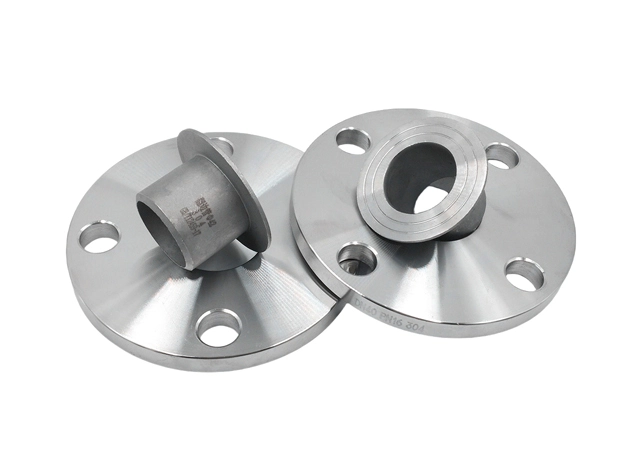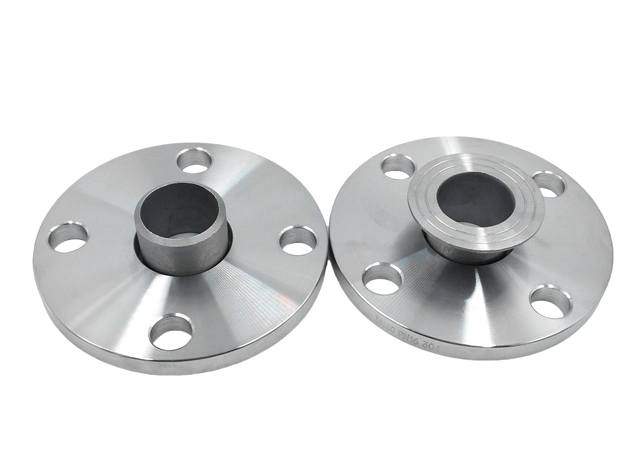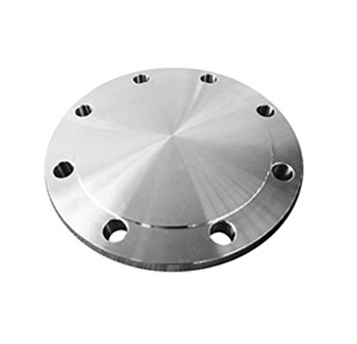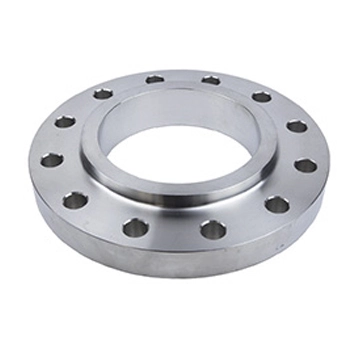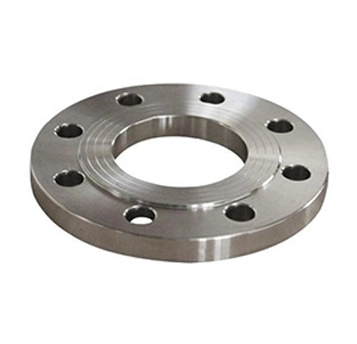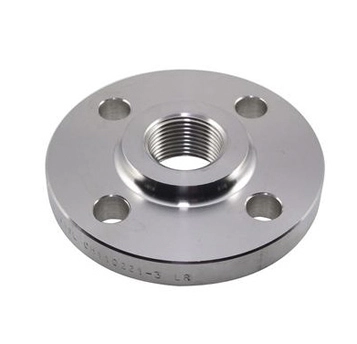What is Lap Joint Flange
A lap joint flange, also known as a loose flange, is a type of flange that consists of a backing ring and a flange ring. The backing ring is usually welded or brazed to the pipe end, and the flange ring can freely rotate around the backing ring.
The main function of lap joint flanges is to provide flexibility and easy installation in piping systems. They are particularly suitable for applications where there is a need for frequent disassembly and assembly, such as in some maintenance-intensive equipment connections. The ability of the flange ring to rotate allows for easier alignment of bolt holes during installation, reducing installation time and effort.
lap joint flanges can accommodate some degree of misalignment and thermal expansion in the pipeline, helping to reduce stress and potential leakage issues, thus enhancing the overall reliability and durability of the piping system.
Types of Lap Joint Flange
Raised Face (RF) Lap Joint Flange
Features a raised face around the sealing area to improve gasket compression.
Compatible with raised face stub ends.
Flat Face (FF) Lap Joint Flange
Has a flat sealing surface, typically used with flat-faced stub ends.
Often used in systems with cast iron or brittle materials.
Ring-Type Joint (RTJ) Lap Joint Flange
Designed with a groove to accommodate a metal ring gasket.
Commonly used in oil and gas pipelines.
Sizes and Pressure Ratings of Lap Joint Flange
Sizes
Nominal Pipe Sizes (NPS): Lap joint flanges are available in sizes ranging from ½” to 24”. For larger sizes (NPS 26” to 60”), the standard ASME B16.47 is applicable.
Dimensions: The dimensions, including outside diameter, bolt circle, and flange thickness, vary based on the size and pressure class. For example, a 1/2" NPS flange in the 2500 lbs class has an outside diameter of 4.75 inches, a bolt circle of 3.25 inches, and a flange thickness of 0.56 inches. As the NPS increases, these dimensions also increase significantly.
Pressure Ratings
Pressure Classes: Lap joint flanges are available in various pressure classes, including 150, 300, 400, 600, 900, 1500, and 2500.
Pressure-Temperature Ratings: The pressure ratings vary based on the service temperature. For example, at 100°F, the pressure rating for a 2500# flange is 6160 psi, while for a 150# flange, it is 275 psi. The ratings decrease as the temperature increases.
Standards of Lap Joint Flange
ASME B16.5
An American standard, it details lap joint flange dimensions, pressure ratings (Class 150 - 2500), and tolerances with specific examples for size and bolt holes.
DIN 2641 and DIN 2642
German standards. DIN 2641 focuses on steel, and DIN 2642 on cast iron lap joint flanges, covering dimensions, materials, etc.
JIS Standards
Japanese Industrial Standards like JIS B2220 regulate lap joint flanges, specifying dimensions and materials, popular in Japan and Asia.
Material Grade of Lap Joint Flange
Carbon Steel Grades
ASTM A105, common for lap joint flanges, offers good mechanicals and weldability. ASTM A234 WPB suits moderate temp & pressure, with better strength.
Stainless Steel Grades
ASTM A182 F304, with 18% Cr and 8% Ni, has great corrosion resistance. F316 adds Mo for enhanced resistance, especially in chloride - rich media.
Alloy Steel Grades
ASTM A182 F11 provides good high - temp strength, used in high - temp/pressure systems. F22, with more Cr and Mo, endures harsh conditions better.
Applications of Lap Joint Flange
Chemical Industry
Lap joint flanges are used in chemical pipelines. Their easy disassembly aids maintenance, and corrosion - resistant types suit handling corrosive chemicals.
Food and Beverage Industry
In this industry, stainless - steel lap joint flanges ensure hygiene. They're used in ingredient - to - product pipelines and are easy to clean between runs.
Pharmaceutical Industry
Needed for high - cleanliness in drug manufacturing. Their quick - disconnection feature helps in equipment maintenance and keeping the environment sterile.
Power Generation
Applied in steam and water pipelines of power plants. They can handle thermal expansion and their easy disassembly simplifies maintenance work.
Marine Industry
Used in ship's piping systems like fuel and cooling lines. Stainless - steel ones resist corrosion, and their easy install - disassembly helps in limited - space shipboard maintenance.

 EN
EN
